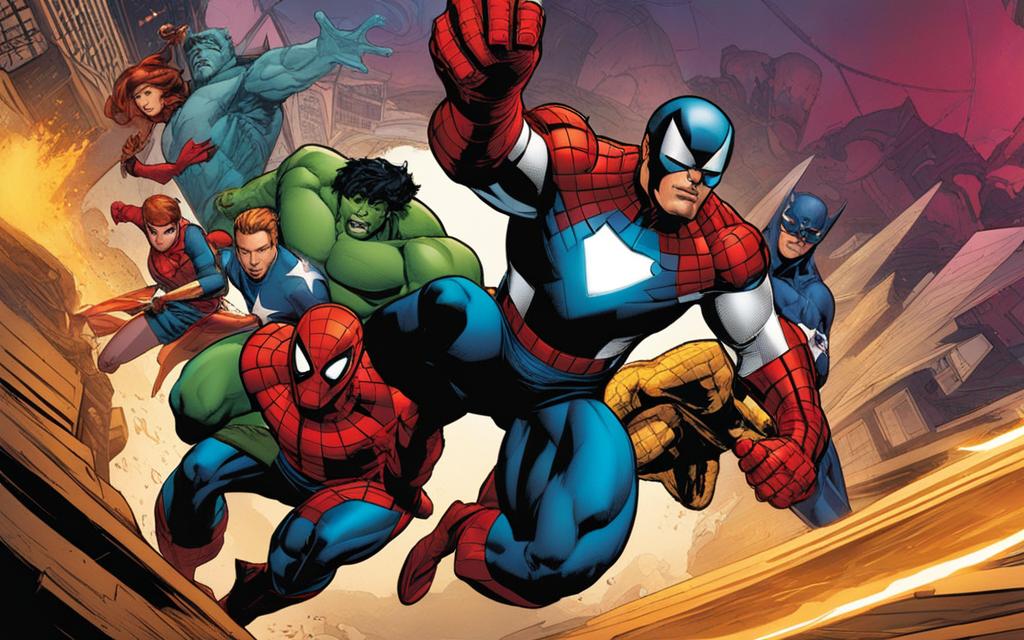Stan Lee, the legendary figure behind the Marvel Universe, had an immeasurable impact on Marvel comics, movies, and superheroes. His creative genius and storytelling prowess revolutionized the industry and left an indelible mark on popular culture.
As the co-creator of countless iconic characters such as Spider-Man, the X-Men, and the Fantastic Four, Stan Lee’s contributions reshaped the superhero genre and propelled Marvel to unprecedented success.
Key Takeaways:
- Stan Lee’s legacy in the Marvel Universe is unparalleled.
- His creative contributions include co-creating beloved characters and revolutionizing storytelling techniques.
- Stan Lee’s influence extends beyond comics to the Marvel Cinematic Universe and other media.
- The Marvel Universe continues to captivate audiences around the world, thanks to Stan Lee’s vision.
- Stan Lee’s legacy serves as a reminder of the enduring power of creativity and the universal appeal of superheroes.
The Early Years of Stan Lee

Stan Lee, born as Stanley Martin Lieber, embarked on his journey in the comic book industry at a young age. Starting as an assistant at Timely Publications, the predecessor to Marvel Comics, Lee’s passion for storytelling and literature formed the bedrock of his future success as a writer and illustrator.
During his time at Timely Publications, Lee honed his skills and gained invaluable insights into the inner workings of the comic book industry. He immersed himself in the world of superheroes and fantastical tales, fueling his imagination and setting the stage for the iconic characters that would later captivate audiences worldwide.
Lee’s early experiences in the comic book industry laid the foundation for his remarkable career and lasting contributions to the Marvel Universe. From his humble beginnings at Timely Publications to becoming a true pioneer in the comic book industry, Stan Lee’s journey is an inspiration to aspiring creators and fans alike.
| Key Points | Details |
|---|---|
| Birth Name | Stanley Martin Lieber |
| Early Workplace | Timely Publications |
| Success as a | Writer and Illustrator |
| Foundation for | Marvel Universe |
The Birth of the Marvel Universe
In the early 1960s, Stan Lee, along with artists Jack Kirby and Steve Ditko, ushered in the Marvel Age of Comics. During this period, they created a roster of iconic superheroes and teams that would become synonymous with Marvel. Characters like Spider-Man, the Fantastic Four, the X-Men, Iron Man, Thor, and the Hulk were brought to life with complex personalities and relatable stories, setting them apart from traditional superheroes.
Stan Lee’s vision and collaboration with talented artists gave birth to a universe that captured the imagination of readers. Marvel Universe became a groundbreaking tapestry of interconnected stories and characters, captivating fans around the world.
“We tried to make all of our characters, even the superheroes, more realistic and human.” – Stan Lee
This new era of superheroes challenged traditional comic book conventions with their flawed personalities, internal struggles, and three-dimensional characteristics. Spider-Man dealt with teenage angst and the responsibility of power, the Fantastic Four showcased the dynamics of a dysfunctional family, and the X-Men explored themes of prejudice and acceptance. These narratives resonated with readers and set a new standard for storytelling in the comic book industry.
The Marvel Age of Comics Timeline
| 1961 | 1962 | 1963 | 1964 |
|---|---|---|---|
| Spider-Man | Fantastic Four | Iron Man | Thor |
| X-Men | Hulk |
The creation of these iconic characters marked the beginning of a new era for Marvel Comics. Each superhero brought a unique flavor to the Marvel Universe, captivating readers with their compelling stories, cosmic adventures, and epic battles against formidable foes.
With characters such as Spider-Man, the Fantastic Four, the X-Men, Iron Man, Thor, and the Hulk at the forefront, Marvel Comics soared to new heights, capturing the hearts of fans and becoming a cultural phenomenon.
The Marvel Method of Storytelling

One of Stan Lee’s significant contributions to the comic book industry was the development of the Marvel Method of storytelling. Instead of providing detailed scripts to artists, Lee collaborated with them, allowing for more creative freedom and resulting in visually dynamic and engaging storytelling. This approach revolutionized the way comics were created and brought a fresh perspective to the medium.
The Marvel Method involved a collaborative process where Lee would provide a general outline of the story to the artist, who would then create the visuals and fill in the details. The artist would then return the illustrated pages to Lee, who would add the dialogue and captions. This method allowed for a more seamless integration of visuals and text, resulting in a more cohesive and immersive reading experience.
By giving artists the freedom to interpret and visualize the story, the Marvel Method opened up new possibilities for creativity and innovation. Artists were able to contribute their own ideas, adding layers of depth and nuance to the storytelling. This collaborative approach not only empowered the artists but also fostered a sense of ownership and investment in the final product.
“The Marvel Method was all about collaboration and trusting the creative instincts of the artists. It allowed for a fluid and dynamic process that brought the stories to life in ways that surpassed our wildest imaginations.” – Stan Lee
The Marvel Method not only led to visually stunning and emotionally resonant stories but also facilitated a faster production process. With less time spent on detailed scripts, artists could focus on bringing the story to life through their illustrations. This method of collaboration and creative freedom became a hallmark of Marvel Comics and set them apart from other publishers.
Through the Marvel Method, Stan Lee fostered a sense of camaraderie and teamwork among creators, resulting in a collaborative environment that nurtured innovation and pushed the boundaries of storytelling. This approach continues to influence the comic book industry to this day, with many creators embracing the spirit of collaboration and creative freedom pioneered by Lee.
Breaking Down Barriers

Stan Lee, a true visionary in the comic book industry, played a vital role in challenging the prevailing perception of comics as mere children’s entertainment. He recognized the artistic and literary value of this medium and tirelessly advocated for its recognition. Lee’s unwavering belief in the power of comics as a legitimate form of storytelling helped break down barriers and elevate the industry to new heights.
One of the ways in which Stan Lee revolutionized the comic book industry was through his innovative use of thought bubbles. Instead of relying solely on dialogue, Lee introduced thought bubbles to provide insight into characters’ inner thoughts and emotions. This artistic technique added depth and complexity to the narratives, capturing readers’ imaginations and fostering a deeper connection to the characters.
“Comic books are an art form, and they can tell stories in a way that no other medium can. They have the power to captivate, inspire, and provoke thought.”
The character-driven narratives created by Stan Lee further solidified the artistic value of comics. He understood that compelling storytelling required well-developed characters with multidimensional personalities. By emphasizing the human struggles, triumphs, and flaws of his characters, Lee brought a level of authenticity and relatability to his stories that resonated with readers of all ages.
Breaking Down Barriers
| Artistic Value | Thought Bubbles | Character-Driven Narratives |
|---|---|---|
| Stan Lee recognized and championed the artistic value of comics, elevating them from mere entertainment to a legitimate form of storytelling. | His introduction of thought bubbles added depth to characters’ inner worlds, engaging readers on a deeper emotional level. | Lee’s character-driven narratives emphasized the human struggles and complexities of his heroes, making them relatable and resonant. |
| By breaking down preconceived notions of comics, Lee paved the way for their acceptance as a respected art form. | The innovative use of thought bubbles propelled comic storytelling into new realms of artistic expression. | The emphasis on well-developed characters elevated the quality and depth of comic book narratives. |
Stan Lee’s Editorial Leadership
In 1972, Stan Lee took on the role of Marvel’s publisher and editorial director, a position he held for several decades. During his tenure, Lee propelled Marvel Comics to new heights through expansion into various media, including animation and television. Marvel’s characters, under his visionary leadership, transformed into cultural icons, gaining widespread recognition and solidifying their place in popular culture.
Lee’s strategic decision to expand Marvel’s reach beyond the pages of comic books allowed the beloved characters to permeate other forms of entertainment, reaching a broader audience and capturing the hearts of fans around the world.
Under his guidance, Marvel Comics not only remained relevant but flourished, building a legacy that continues to thrive today. Lee’s knack for storytelling and his commitment to pushing boundaries ensured that Marvel’s characters transcended the confines of the comic book world, becoming household names and cultural touchstones.
The Marvel Cinematic Universe
Perhaps Stan Lee’s most significant impact on popular culture came through the Marvel Cinematic Universe (MCU). The success of films like “Iron Man,” “The Avengers,” and “Black Panther” can be attributed, in part, to Lee’s vision. His cameos in nearly every MCU film endeared him to a new generation of fans and solidified his status as a beloved figure in the entertainment industry.
Since its inception in 2008 with “Iron Man,” the Marvel Cinematic Universe has become a global phenomenon, captivating audiences with its interconnected storytelling and compelling characters. The MCU has expanded to include over 20 films, each contributing to a vast and intricate universe filled with superheroes, epic battles, and thrilling adventures.
One of the key strengths of the MCU is its ability to interweave standalone superhero films while maintaining a cohesive narrative. Audiences eagerly anticipate each new installment, eagerly connecting the dots between films and eagerly discussing theories and predictions.
“I think the success of the Marvel films is due in large part to Stan Lee’s vision. His creativity and passion for storytelling laid the foundation for what would become a groundbreaking cinematic universe.”
– Marvel fan
Stan Lee’s cameo appearances in the MCU films added an extra layer of excitement and nostalgia for fans. From his memorable portrayal of a hapless delivery man to a wise elder, each cameo was a delightful nod to Lee’s legacy and his enduring impact on Marvel.
Thanks to the MCU, characters such as Iron Man, Captain America, Thor, and Black Widow have become cultural icons, inspiring countless fans and paving the way for further exploration of diversity and representation in superhero films. The success of the MCU has created a shared language of superhero storytelling, uniting fans around the world.
Ultimately, the Marvel Cinematic Universe stands as a testament to Stan Lee’s incredible imagination and his ability to create characters and stories that resonate with audiences of all ages. His vision has forever changed the landscape of superhero films and solidified Marvel’s place in cinematic history.
| Film | Release Date | Box Office Gross |
|---|---|---|
| Iron Man | 2008 | $585.2 million |
| The Avengers | 2012 | $1.5 billion |
| Black Panther | 2018 | $1.3 billion |
| Avengers: Endgame | 2019 | $2.8 billion |
Conclusion
Stan Lee’s legacy in the comic book industry and popular culture is undeniably profound. Through his creativity, he brought to life complex characters and pioneered innovative storytelling techniques that continue to captivate audiences worldwide. The Marvel Universe, which he helped build, stands as a testament to his enduring impact on the superhero genre.
Lee’s contributions to storytelling transformed the way we perceive superheroes, infusing them with relatable qualities and intricate narratives. His characters, such as Spider-Man, Iron Man, and the X-Men, resonate with audiences on a deep level, reflecting the universal human experience through their struggles and triumphs.
As a true icon in the world of comics and entertainment, Stan Lee’s legacy will continue to inspire creativity for generations to come. His remarkable vision and dedication have not only shaped the Marvel Universe but also influenced the broader landscape of storytelling. Through his work, he reminds us of the extraordinary power of imagination and the timeless appeal of superheroes.
FAQ
How did Stan Lee impact the Marvel Universe?
Stan Lee had a profound impact on the Marvel Universe through his creative contributions, co-creating iconic characters, and revolutionizing the way comic books are written and illustrated.
What is Stan Lee’s legacy?
Stan Lee’s legacy is a universe of memorable superheroes, compelling stories, and the popularization of comic book culture. His influence extends beyond comic books to films, television, and popular culture as a whole.
Which Marvel superheroes did Stan Lee create?
Stan Lee co-created numerous popular Marvel superheroes, including Spider-Man, the Fantastic Four, the X-Men, Iron Man, Thor, and the Hulk.
What is the Marvel Method of storytelling?
The Marvel Method is a collaborative approach to comic book storytelling pioneered by Stan Lee. Instead of providing detailed scripts, Lee worked with artists, allowing them more creative freedom in illustrating the story.
How did Stan Lee break down barriers in the comic book industry?
Stan Lee advocated for the artistic and literary value of comics and introduced innovative techniques like thought bubbles and character-driven narratives, elevating comics from mere entertainment to a legitimate form of storytelling.
What role did Stan Lee play in Marvel Comics’ expansion?
Stan Lee became Marvel’s publisher and editorial director, overseeing the company’s expansion into various media, including animation and television. Under his leadership, Marvel’s characters became cultural icons and gained widespread recognition.
How did Stan Lee contribute to the Marvel Cinematic Universe?
Stan Lee’s vision played a significant role in the success of the Marvel Cinematic Universe. His cameos in nearly every MCU film endeared him to fans and solidified his status as a beloved figure in the entertainment industry.
What is Stan Lee’s lasting legacy?
Stan Lee’s legacy is one of creativity, storytelling, and the enduring appeal of superheroes. His contributions to the Marvel Universe continue to captivate audiences worldwide, reminding us of the power of imagination and the impact of a great story.
Source Links
- https://blog.wolfestone.co.uk/stan-lee-marvel-and-their-global-impact
- https://www.toonsmag.com/stan-lee-on-the-comic-book-industry/
- https://www.vox.com/2016/2/23/11098942/stan-lee-death-marvel-legacy
As we’ve explored the monumental legacy of Stan Lee and his indelible mark on the Marvel Universe, it’s clear that his vision has not only shaped the past and present of superhero storytelling but also lays a foundation for future generations. Stan Lee’s characters and stories have transcended comic book pages, becoming a pivotal part of our cultural fabric and continuing to inspire creativity, courage, and hope across the globe.
Now, we turn to you, the fans and readers, who have been part of this incredible journey. How do you see Stan Lee’s legacy evolving in the years to come? What new directions do you envision for the Marvel Universe that build upon his extraordinary contributions? Share your thoughts, predictions, and dreams in the comments below. Let’s honor Stan Lee’s memory by looking forward to the endless possibilities his work has set in motion. Excelsior!

